Child Health and Development
VerifiedAdded on 2020/05/08
|13
|3262
|132
AI Summary
The assignment focuses on child health, emphasizing the importance of proper nutrition from birth through adolescence. It highlights the growing concern of childhood obesity due to poor dietary choices, contrasting younger children's preference for fruits, vegetables, and dairy with older children's inclination towards junk food. The document also addresses neonatal mortality rates and suggests solutions like training childcare professionals, equipping healthcare facilities, and providing quality care. It underscores the need for understanding child development, fostering positive self-image, offering additional support, and ensuring safety to promote optimal child health.
Contribute Materials
Your contribution can guide someone’s learning journey. Share your
documents today.

Running head: CHILD HEALTH
Child health
Name of the student:
Name of the university:
Author note:
Table of Contents
Child health
Name of the student:
Name of the university:
Author note:
Table of Contents
Secure Best Marks with AI Grader
Need help grading? Try our AI Grader for instant feedback on your assignments.
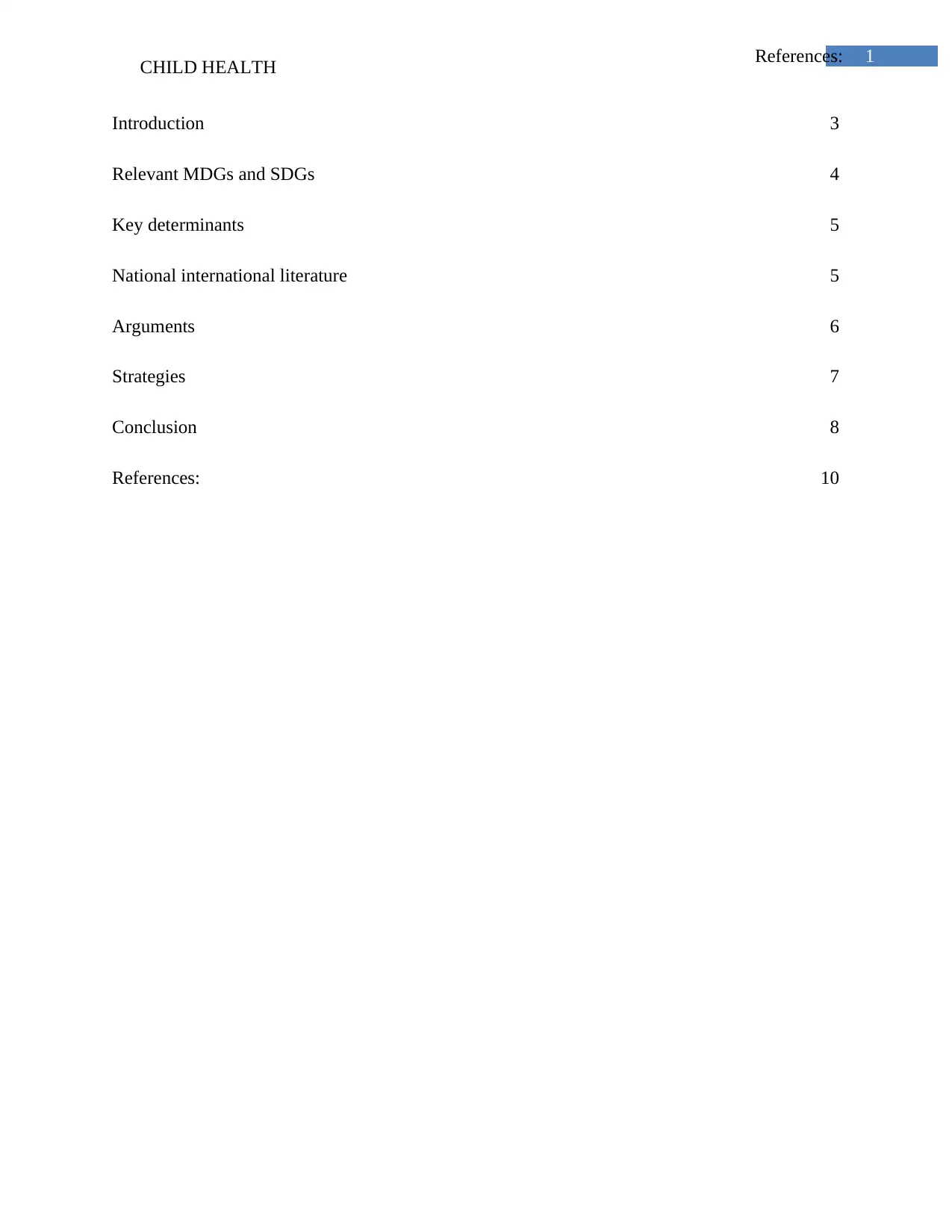
1References:
CHILD HEALTH
Introduction 3
Relevant MDGs and SDGs 4
Key determinants 5
National international literature 5
Arguments 6
Strategies 7
Conclusion 8
References: 10
CHILD HEALTH
Introduction 3
Relevant MDGs and SDGs 4
Key determinants 5
National international literature 5
Arguments 6
Strategies 7
Conclusion 8
References: 10

2References:
CHILD HEALTH
Introduction
The right good health is a basic right that each and every individual has a right to, however
children can be considered as the future of our society; hence the health status of the children
must receive extra attention as a public health priority. Unfortunately, the health status of the
children is the neglected alarmingly all over the world and this instrumental negligence has
contributed alarmingly to the rapidly deteriorating health conditions of the children all over the
world. It has to be understood that there have been a steady decrease in the health status of the
children, and the statistics are even more alarming for Australia (Victora et al. 2012).
Considering the statistical data from the past three to four years, the child mortality rates
have decreased significantly from the past decade, however still, almost 70% of the total rate in
the present can be contributed by the number of infant mortality rates. The total number of infant
deaths in Australia had been 1012, and this ghastly status of current neonatal health status for
Australia is one of the major public health concerns (Brinkman et al. 2012). However it has to be
mentioned that the child death rate on an overall scale has decreased from 8.8% to 3.4% per
1000 live births, which is an appreciable effort over all. However it can not be denied that there
is a significant room for more improvements and in order attain optimal health status for children
a robust health improvement strategy will be required. This report will attempt to explore the
health development goals and objectives for better child health status and evaluate the current
status of child health in the hopes of gaining a better understanding of the escalating issue taking
the example of Australia.
CHILD HEALTH
Introduction
The right good health is a basic right that each and every individual has a right to, however
children can be considered as the future of our society; hence the health status of the children
must receive extra attention as a public health priority. Unfortunately, the health status of the
children is the neglected alarmingly all over the world and this instrumental negligence has
contributed alarmingly to the rapidly deteriorating health conditions of the children all over the
world. It has to be understood that there have been a steady decrease in the health status of the
children, and the statistics are even more alarming for Australia (Victora et al. 2012).
Considering the statistical data from the past three to four years, the child mortality rates
have decreased significantly from the past decade, however still, almost 70% of the total rate in
the present can be contributed by the number of infant mortality rates. The total number of infant
deaths in Australia had been 1012, and this ghastly status of current neonatal health status for
Australia is one of the major public health concerns (Brinkman et al. 2012). However it has to be
mentioned that the child death rate on an overall scale has decreased from 8.8% to 3.4% per
1000 live births, which is an appreciable effort over all. However it can not be denied that there
is a significant room for more improvements and in order attain optimal health status for children
a robust health improvement strategy will be required. This report will attempt to explore the
health development goals and objectives for better child health status and evaluate the current
status of child health in the hopes of gaining a better understanding of the escalating issue taking
the example of Australia.
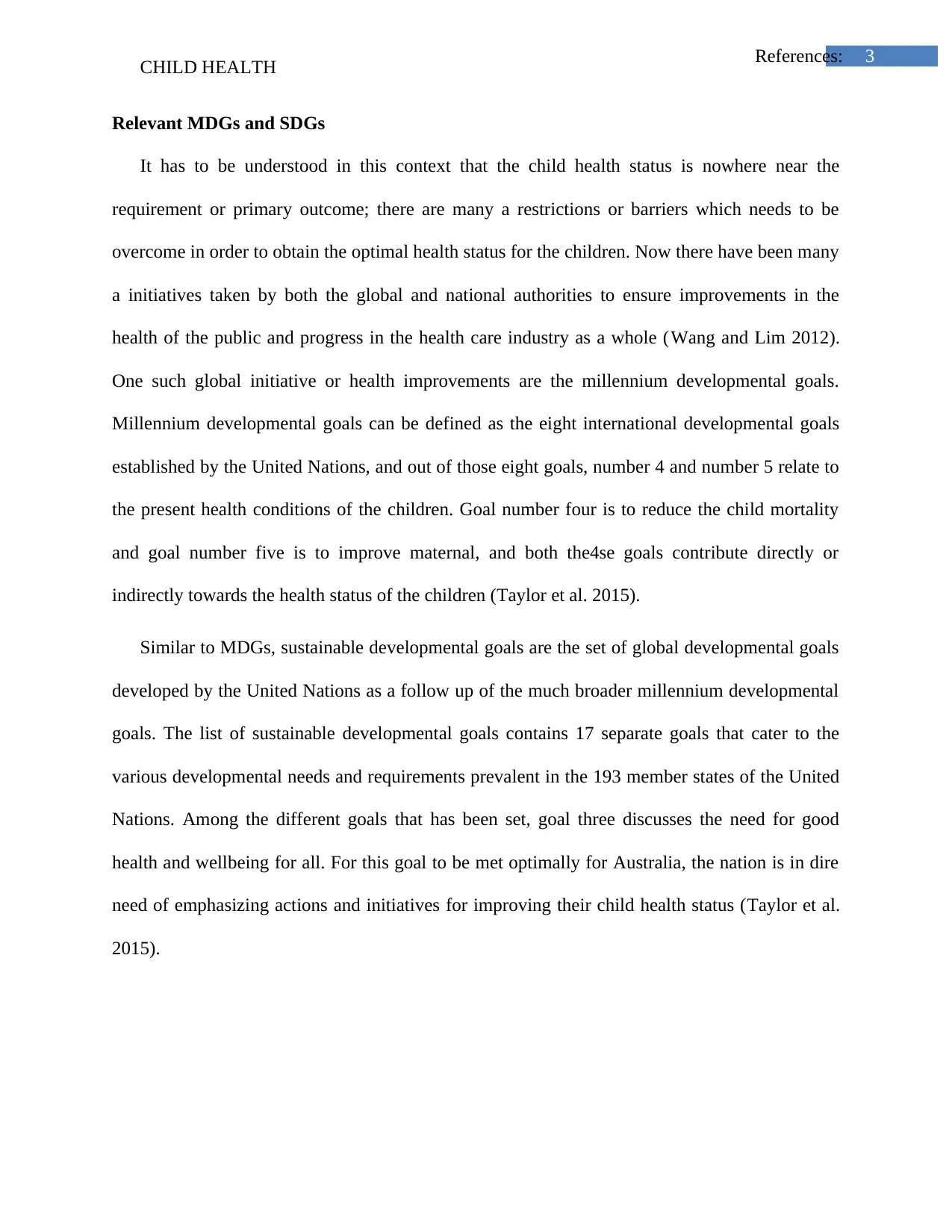
3References:
CHILD HEALTH
Relevant MDGs and SDGs
It has to be understood in this context that the child health status is nowhere near the
requirement or primary outcome; there are many a restrictions or barriers which needs to be
overcome in order to obtain the optimal health status for the children. Now there have been many
a initiatives taken by both the global and national authorities to ensure improvements in the
health of the public and progress in the health care industry as a whole (Wang and Lim 2012).
One such global initiative or health improvements are the millennium developmental goals.
Millennium developmental goals can be defined as the eight international developmental goals
established by the United Nations, and out of those eight goals, number 4 and number 5 relate to
the present health conditions of the children. Goal number four is to reduce the child mortality
and goal number five is to improve maternal, and both the4se goals contribute directly or
indirectly towards the health status of the children (Taylor et al. 2015).
Similar to MDGs, sustainable developmental goals are the set of global developmental goals
developed by the United Nations as a follow up of the much broader millennium developmental
goals. The list of sustainable developmental goals contains 17 separate goals that cater to the
various developmental needs and requirements prevalent in the 193 member states of the United
Nations. Among the different goals that has been set, goal three discusses the need for good
health and wellbeing for all. For this goal to be met optimally for Australia, the nation is in dire
need of emphasizing actions and initiatives for improving their child health status (Taylor et al.
2015).
CHILD HEALTH
Relevant MDGs and SDGs
It has to be understood in this context that the child health status is nowhere near the
requirement or primary outcome; there are many a restrictions or barriers which needs to be
overcome in order to obtain the optimal health status for the children. Now there have been many
a initiatives taken by both the global and national authorities to ensure improvements in the
health of the public and progress in the health care industry as a whole (Wang and Lim 2012).
One such global initiative or health improvements are the millennium developmental goals.
Millennium developmental goals can be defined as the eight international developmental goals
established by the United Nations, and out of those eight goals, number 4 and number 5 relate to
the present health conditions of the children. Goal number four is to reduce the child mortality
and goal number five is to improve maternal, and both the4se goals contribute directly or
indirectly towards the health status of the children (Taylor et al. 2015).
Similar to MDGs, sustainable developmental goals are the set of global developmental goals
developed by the United Nations as a follow up of the much broader millennium developmental
goals. The list of sustainable developmental goals contains 17 separate goals that cater to the
various developmental needs and requirements prevalent in the 193 member states of the United
Nations. Among the different goals that has been set, goal three discusses the need for good
health and wellbeing for all. For this goal to be met optimally for Australia, the nation is in dire
need of emphasizing actions and initiatives for improving their child health status (Taylor et al.
2015).
Secure Best Marks with AI Grader
Need help grading? Try our AI Grader for instant feedback on your assignments.

4References:
CHILD HEALTH
Key determinants
There are various barriers to optimal child health all over the world, be it societal,
environmental or economic, and the conditions in Australia is no exception to this phenomenon.
According to the most of the authors, there is a distinct socio-cultural pattern of dominance on
health and development and the socio-cultural factors, coupled with environmental restrictions
are the key determinants of child health in Australia (Badland et al. 2014). Among the socio-
cultural determinants, the advantages or discrepancies faced throughout their life contributes
largely to the health status of different groups of children, and this gradient of societal privilege
is mostly dependent upon the socio-economic status of the individual. The level of health literacy
in the parental groups is also a key indicator of the health status of the children. According to a
recent analysis of WHO, the parental and postnatal experience of the children contribute largely
to the health status that they develop eventually. Lastly, the lifestyle or living conditions and
nutritional status of the children also is a key indicator of the health condition they have all
throughout their life (Riggs et al. 2012).
National international literature
According to the report of Fotso and Fogarty (2015), Millennium Development Goals
(MDGs) have been able to play a major role in focusing the Global attention of child
development care in all parts of Australia. One of the major causes of the success is due to the
fact that all the goals were set based upon the time bound scale. This was possible mainly due to
the achievement alongside with sustainable development goals (SDGs). The child has been one
of the major concerns in the goals of MDGs and SDGs. In case of Australia, the goal has been
able to implemented depending upon the social and economic status of child health. Being one of
CHILD HEALTH
Key determinants
There are various barriers to optimal child health all over the world, be it societal,
environmental or economic, and the conditions in Australia is no exception to this phenomenon.
According to the most of the authors, there is a distinct socio-cultural pattern of dominance on
health and development and the socio-cultural factors, coupled with environmental restrictions
are the key determinants of child health in Australia (Badland et al. 2014). Among the socio-
cultural determinants, the advantages or discrepancies faced throughout their life contributes
largely to the health status of different groups of children, and this gradient of societal privilege
is mostly dependent upon the socio-economic status of the individual. The level of health literacy
in the parental groups is also a key indicator of the health status of the children. According to a
recent analysis of WHO, the parental and postnatal experience of the children contribute largely
to the health status that they develop eventually. Lastly, the lifestyle or living conditions and
nutritional status of the children also is a key indicator of the health condition they have all
throughout their life (Riggs et al. 2012).
National international literature
According to the report of Fotso and Fogarty (2015), Millennium Development Goals
(MDGs) have been able to play a major role in focusing the Global attention of child
development care in all parts of Australia. One of the major causes of the success is due to the
fact that all the goals were set based upon the time bound scale. This was possible mainly due to
the achievement alongside with sustainable development goals (SDGs). The child has been one
of the major concerns in the goals of MDGs and SDGs. In case of Australia, the goal has been
able to implemented depending upon the social and economic status of child health. Being one of
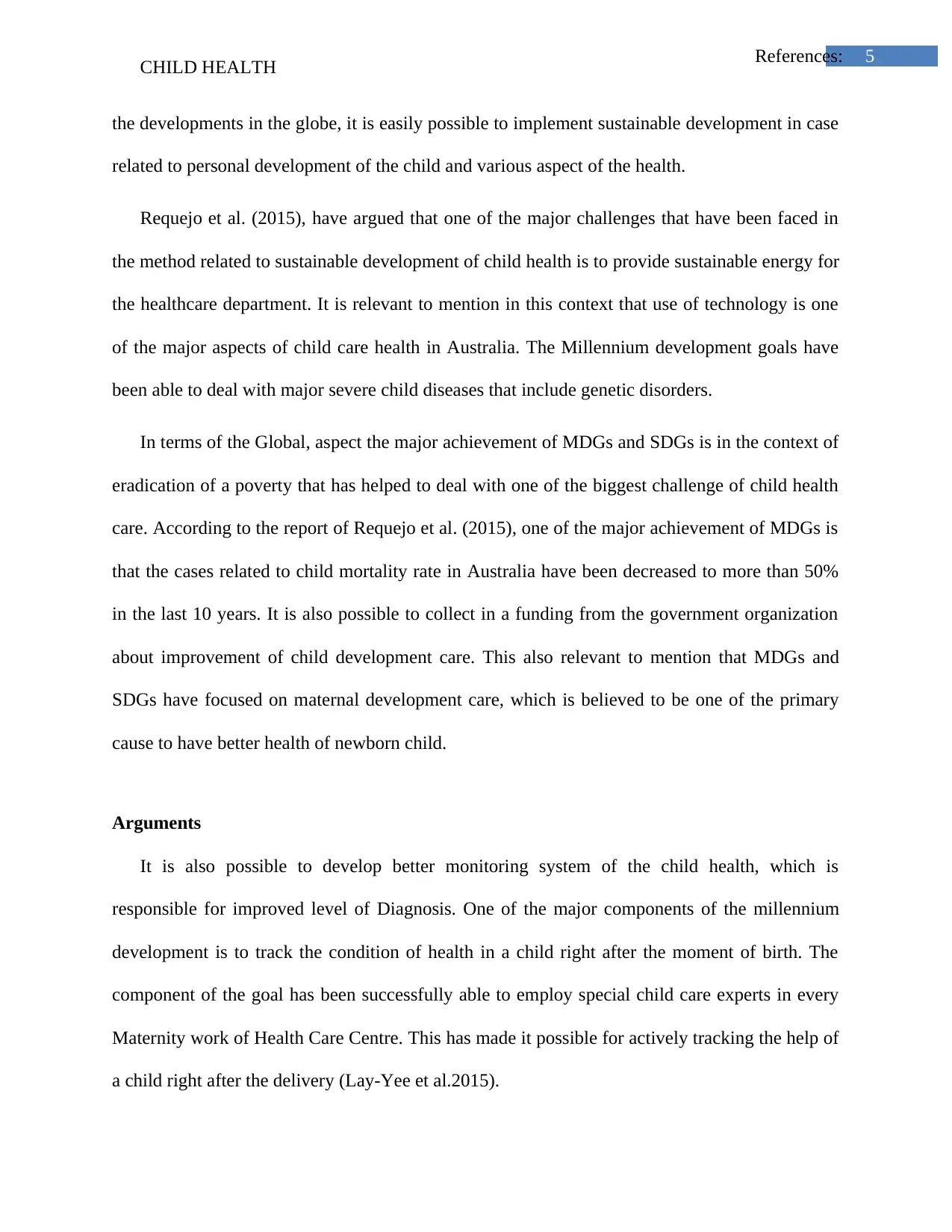
5References:
CHILD HEALTH
the developments in the globe, it is easily possible to implement sustainable development in case
related to personal development of the child and various aspect of the health.
Requejo et al. (2015), have argued that one of the major challenges that have been faced in
the method related to sustainable development of child health is to provide sustainable energy for
the healthcare department. It is relevant to mention in this context that use of technology is one
of the major aspects of child care health in Australia. The Millennium development goals have
been able to deal with major severe child diseases that include genetic disorders.
In terms of the Global, aspect the major achievement of MDGs and SDGs is in the context of
eradication of a poverty that has helped to deal with one of the biggest challenge of child health
care. According to the report of Requejo et al. (2015), one of the major achievement of MDGs is
that the cases related to child mortality rate in Australia have been decreased to more than 50%
in the last 10 years. It is also possible to collect in a funding from the government organization
about improvement of child development care. This also relevant to mention that MDGs and
SDGs have focused on maternal development care, which is believed to be one of the primary
cause to have better health of newborn child.
Arguments
It is also possible to develop better monitoring system of the child health, which is
responsible for improved level of Diagnosis. One of the major components of the millennium
development is to track the condition of health in a child right after the moment of birth. The
component of the goal has been successfully able to employ special child care experts in every
Maternity work of Health Care Centre. This has made it possible for actively tracking the help of
a child right after the delivery (Lay-Yee et al.2015).
CHILD HEALTH
the developments in the globe, it is easily possible to implement sustainable development in case
related to personal development of the child and various aspect of the health.
Requejo et al. (2015), have argued that one of the major challenges that have been faced in
the method related to sustainable development of child health is to provide sustainable energy for
the healthcare department. It is relevant to mention in this context that use of technology is one
of the major aspects of child care health in Australia. The Millennium development goals have
been able to deal with major severe child diseases that include genetic disorders.
In terms of the Global, aspect the major achievement of MDGs and SDGs is in the context of
eradication of a poverty that has helped to deal with one of the biggest challenge of child health
care. According to the report of Requejo et al. (2015), one of the major achievement of MDGs is
that the cases related to child mortality rate in Australia have been decreased to more than 50%
in the last 10 years. It is also possible to collect in a funding from the government organization
about improvement of child development care. This also relevant to mention that MDGs and
SDGs have focused on maternal development care, which is believed to be one of the primary
cause to have better health of newborn child.
Arguments
It is also possible to develop better monitoring system of the child health, which is
responsible for improved level of Diagnosis. One of the major components of the millennium
development is to track the condition of health in a child right after the moment of birth. The
component of the goal has been successfully able to employ special child care experts in every
Maternity work of Health Care Centre. This has made it possible for actively tracking the help of
a child right after the delivery (Lay-Yee et al.2015).

6References:
CHILD HEALTH
It is also possible to implement and develop civil society, which is needed from partnership
with the World Health Organization and meeting up with the guidelines of child care
development. One of the major important successes of the goal in MDGs and SDGs is related
with the reduction of total number of patient in HIV or AIDS and malaria (Nigatu et al. 2014).
This has been one of the major health issue encountered by young aged children in Australia.
The implementation of the goals of Sustainable and Millennium development it is possible to
significantly reduce the number of child patient suffering from deadly diseases. It is also possible
to properly track the occurrence of AIDS among the pregnant women, which will reduce the
chance of spreading of HIV to the children (Smith et al. 2014).
All this goals is associated with sustainable development, that is believed to be one of the
major effective way ensure that all health resources are being properly utilized in providing the
best Health Care guideline for children (Glenton et al. 2013)
Strategies
In the recent years it has been reported that the levels of child neglect from the healthcare and
abuse have increased in Australia. Protection of the children is everyone’s responsibility and for
this protection Australian government has established a national framework for protecting the
children for the year 2009-2010 (Currie and Reichman 2015). This framework is committed for
the implementation of the actions which will help to protect the children and take care of their
health. Australian government had also introduced some vaccines that are being approved by the
therapeutic goods administration (TGA). This TGA used to monitor the safety of the medicines
that are being used in Australia (Leyland et al. 2016). The country has various network or the
health care communities which help in the development of the child. These organizations mainly
CHILD HEALTH
It is also possible to implement and develop civil society, which is needed from partnership
with the World Health Organization and meeting up with the guidelines of child care
development. One of the major important successes of the goal in MDGs and SDGs is related
with the reduction of total number of patient in HIV or AIDS and malaria (Nigatu et al. 2014).
This has been one of the major health issue encountered by young aged children in Australia.
The implementation of the goals of Sustainable and Millennium development it is possible to
significantly reduce the number of child patient suffering from deadly diseases. It is also possible
to properly track the occurrence of AIDS among the pregnant women, which will reduce the
chance of spreading of HIV to the children (Smith et al. 2014).
All this goals is associated with sustainable development, that is believed to be one of the
major effective way ensure that all health resources are being properly utilized in providing the
best Health Care guideline for children (Glenton et al. 2013)
Strategies
In the recent years it has been reported that the levels of child neglect from the healthcare and
abuse have increased in Australia. Protection of the children is everyone’s responsibility and for
this protection Australian government has established a national framework for protecting the
children for the year 2009-2010 (Currie and Reichman 2015). This framework is committed for
the implementation of the actions which will help to protect the children and take care of their
health. Australian government had also introduced some vaccines that are being approved by the
therapeutic goods administration (TGA). This TGA used to monitor the safety of the medicines
that are being used in Australia (Leyland et al. 2016). The country has various network or the
health care communities which help in the development of the child. These organizations mainly
Paraphrase This Document
Need a fresh take? Get an instant paraphrase of this document with our AI Paraphraser
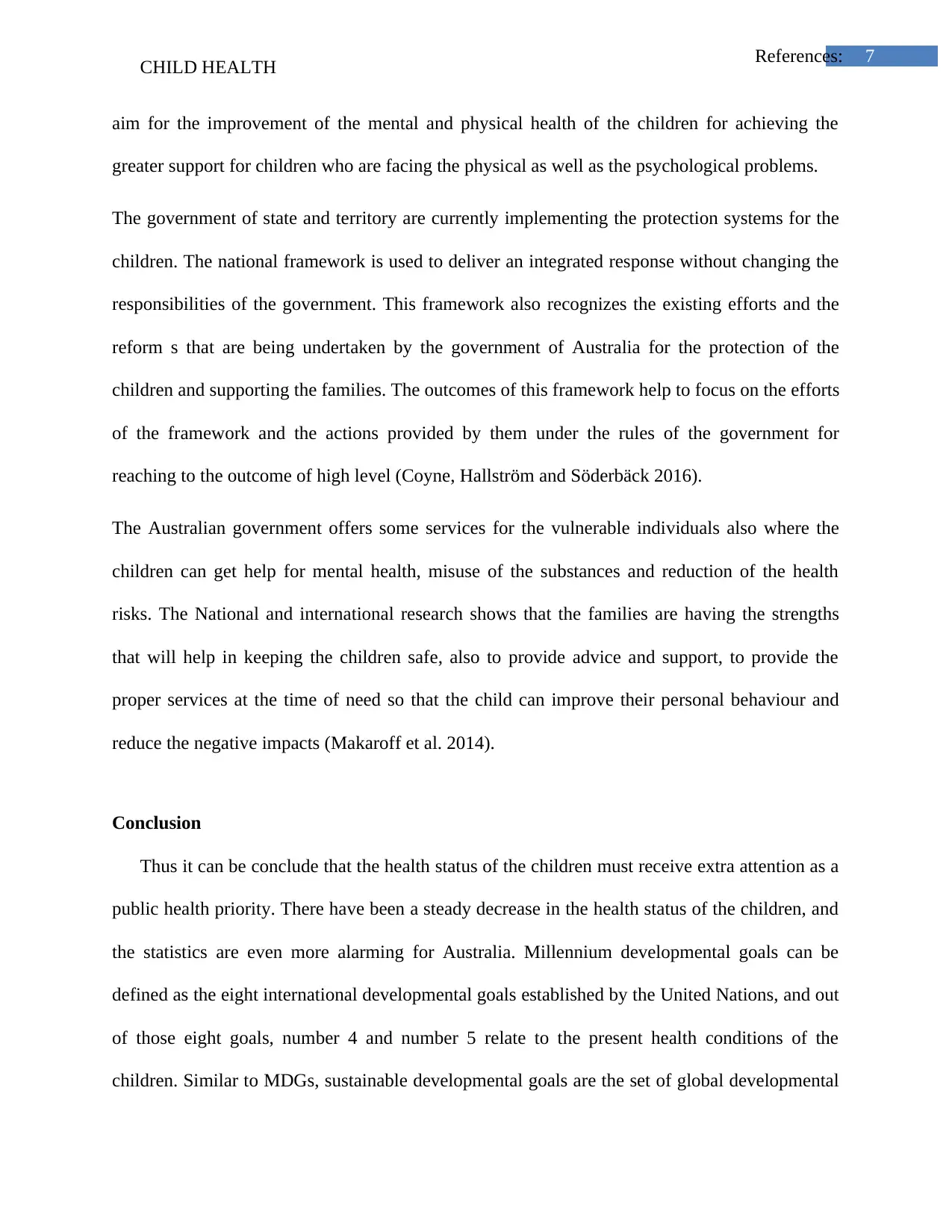
7References:
CHILD HEALTH
aim for the improvement of the mental and physical health of the children for achieving the
greater support for children who are facing the physical as well as the psychological problems.
The government of state and territory are currently implementing the protection systems for the
children. The national framework is used to deliver an integrated response without changing the
responsibilities of the government. This framework also recognizes the existing efforts and the
reform s that are being undertaken by the government of Australia for the protection of the
children and supporting the families. The outcomes of this framework help to focus on the efforts
of the framework and the actions provided by them under the rules of the government for
reaching to the outcome of high level (Coyne, Hallström and Söderbäck 2016).
The Australian government offers some services for the vulnerable individuals also where the
children can get help for mental health, misuse of the substances and reduction of the health
risks. The National and international research shows that the families are having the strengths
that will help in keeping the children safe, also to provide advice and support, to provide the
proper services at the time of need so that the child can improve their personal behaviour and
reduce the negative impacts (Makaroff et al. 2014).
Conclusion
Thus it can be conclude that the health status of the children must receive extra attention as a
public health priority. There have been a steady decrease in the health status of the children, and
the statistics are even more alarming for Australia. Millennium developmental goals can be
defined as the eight international developmental goals established by the United Nations, and out
of those eight goals, number 4 and number 5 relate to the present health conditions of the
children. Similar to MDGs, sustainable developmental goals are the set of global developmental
CHILD HEALTH
aim for the improvement of the mental and physical health of the children for achieving the
greater support for children who are facing the physical as well as the psychological problems.
The government of state and territory are currently implementing the protection systems for the
children. The national framework is used to deliver an integrated response without changing the
responsibilities of the government. This framework also recognizes the existing efforts and the
reform s that are being undertaken by the government of Australia for the protection of the
children and supporting the families. The outcomes of this framework help to focus on the efforts
of the framework and the actions provided by them under the rules of the government for
reaching to the outcome of high level (Coyne, Hallström and Söderbäck 2016).
The Australian government offers some services for the vulnerable individuals also where the
children can get help for mental health, misuse of the substances and reduction of the health
risks. The National and international research shows that the families are having the strengths
that will help in keeping the children safe, also to provide advice and support, to provide the
proper services at the time of need so that the child can improve their personal behaviour and
reduce the negative impacts (Makaroff et al. 2014).
Conclusion
Thus it can be conclude that the health status of the children must receive extra attention as a
public health priority. There have been a steady decrease in the health status of the children, and
the statistics are even more alarming for Australia. Millennium developmental goals can be
defined as the eight international developmental goals established by the United Nations, and out
of those eight goals, number 4 and number 5 relate to the present health conditions of the
children. Similar to MDGs, sustainable developmental goals are the set of global developmental
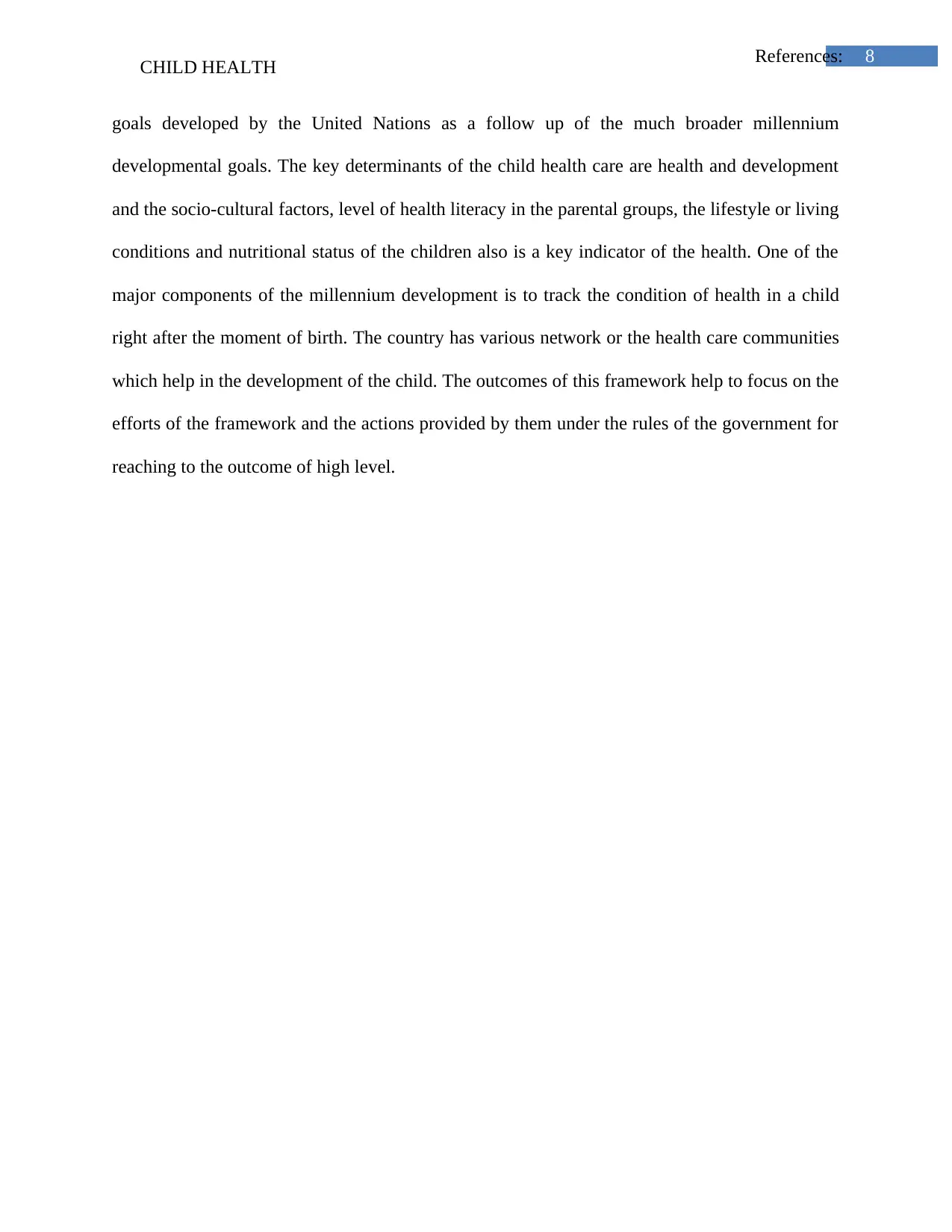
8References:
CHILD HEALTH
goals developed by the United Nations as a follow up of the much broader millennium
developmental goals. The key determinants of the child health care are health and development
and the socio-cultural factors, level of health literacy in the parental groups, the lifestyle or living
conditions and nutritional status of the children also is a key indicator of the health. One of the
major components of the millennium development is to track the condition of health in a child
right after the moment of birth. The country has various network or the health care communities
which help in the development of the child. The outcomes of this framework help to focus on the
efforts of the framework and the actions provided by them under the rules of the government for
reaching to the outcome of high level.
CHILD HEALTH
goals developed by the United Nations as a follow up of the much broader millennium
developmental goals. The key determinants of the child health care are health and development
and the socio-cultural factors, level of health literacy in the parental groups, the lifestyle or living
conditions and nutritional status of the children also is a key indicator of the health. One of the
major components of the millennium development is to track the condition of health in a child
right after the moment of birth. The country has various network or the health care communities
which help in the development of the child. The outcomes of this framework help to focus on the
efforts of the framework and the actions provided by them under the rules of the government for
reaching to the outcome of high level.
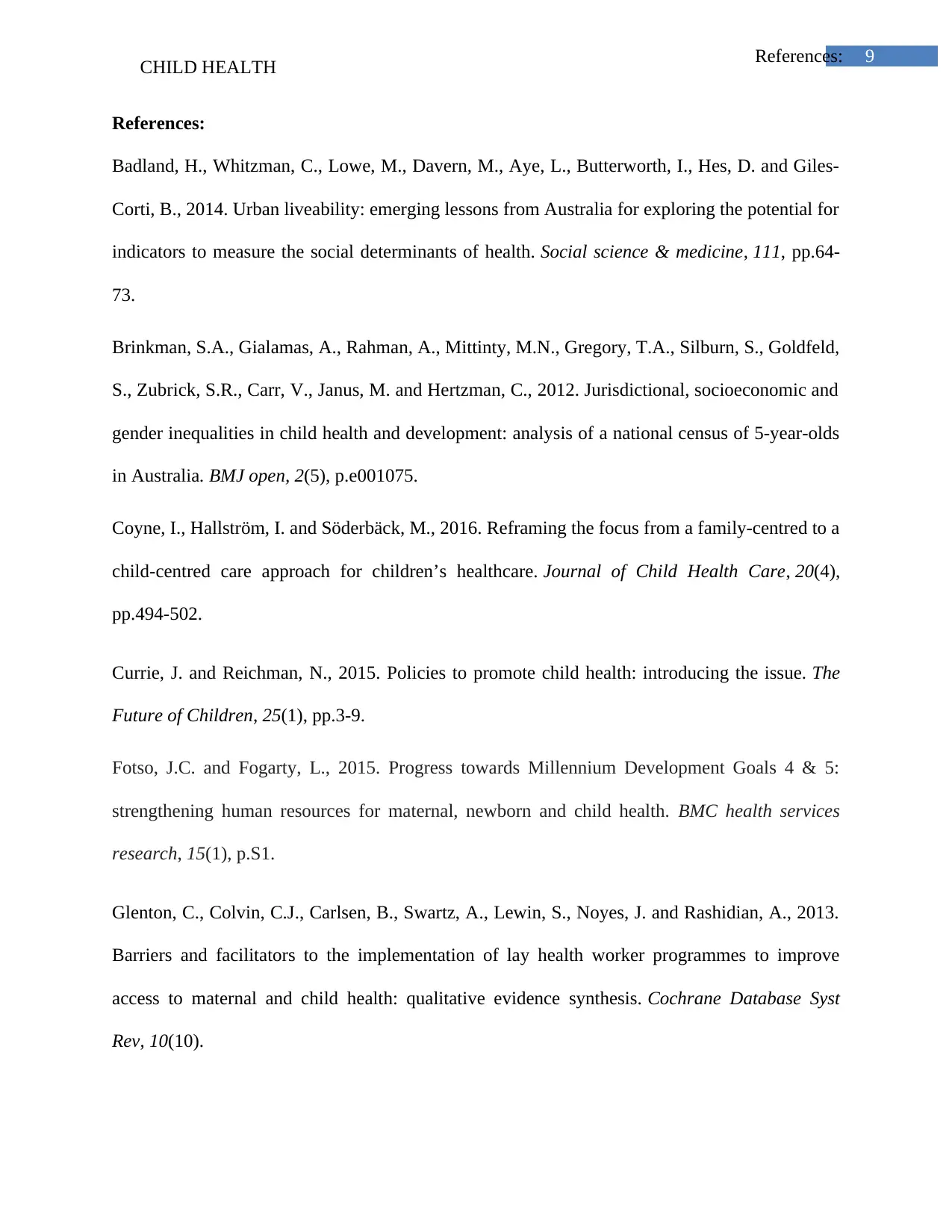
9References:
CHILD HEALTH
References:
Badland, H., Whitzman, C., Lowe, M., Davern, M., Aye, L., Butterworth, I., Hes, D. and Giles-
Corti, B., 2014. Urban liveability: emerging lessons from Australia for exploring the potential for
indicators to measure the social determinants of health. Social science & medicine, 111, pp.64-
73.
Brinkman, S.A., Gialamas, A., Rahman, A., Mittinty, M.N., Gregory, T.A., Silburn, S., Goldfeld,
S., Zubrick, S.R., Carr, V., Janus, M. and Hertzman, C., 2012. Jurisdictional, socioeconomic and
gender inequalities in child health and development: analysis of a national census of 5-year-olds
in Australia. BMJ open, 2(5), p.e001075.
Coyne, I., Hallström, I. and Söderbäck, M., 2016. Reframing the focus from a family-centred to a
child-centred care approach for children’s healthcare. Journal of Child Health Care, 20(4),
pp.494-502.
Currie, J. and Reichman, N., 2015. Policies to promote child health: introducing the issue. The
Future of Children, 25(1), pp.3-9.
Fotso, J.C. and Fogarty, L., 2015. Progress towards Millennium Development Goals 4 & 5:
strengthening human resources for maternal, newborn and child health. BMC health services
research, 15(1), p.S1.
Glenton, C., Colvin, C.J., Carlsen, B., Swartz, A., Lewin, S., Noyes, J. and Rashidian, A., 2013.
Barriers and facilitators to the implementation of lay health worker programmes to improve
access to maternal and child health: qualitative evidence synthesis. Cochrane Database Syst
Rev, 10(10).
CHILD HEALTH
References:
Badland, H., Whitzman, C., Lowe, M., Davern, M., Aye, L., Butterworth, I., Hes, D. and Giles-
Corti, B., 2014. Urban liveability: emerging lessons from Australia for exploring the potential for
indicators to measure the social determinants of health. Social science & medicine, 111, pp.64-
73.
Brinkman, S.A., Gialamas, A., Rahman, A., Mittinty, M.N., Gregory, T.A., Silburn, S., Goldfeld,
S., Zubrick, S.R., Carr, V., Janus, M. and Hertzman, C., 2012. Jurisdictional, socioeconomic and
gender inequalities in child health and development: analysis of a national census of 5-year-olds
in Australia. BMJ open, 2(5), p.e001075.
Coyne, I., Hallström, I. and Söderbäck, M., 2016. Reframing the focus from a family-centred to a
child-centred care approach for children’s healthcare. Journal of Child Health Care, 20(4),
pp.494-502.
Currie, J. and Reichman, N., 2015. Policies to promote child health: introducing the issue. The
Future of Children, 25(1), pp.3-9.
Fotso, J.C. and Fogarty, L., 2015. Progress towards Millennium Development Goals 4 & 5:
strengthening human resources for maternal, newborn and child health. BMC health services
research, 15(1), p.S1.
Glenton, C., Colvin, C.J., Carlsen, B., Swartz, A., Lewin, S., Noyes, J. and Rashidian, A., 2013.
Barriers and facilitators to the implementation of lay health worker programmes to improve
access to maternal and child health: qualitative evidence synthesis. Cochrane Database Syst
Rev, 10(10).
Secure Best Marks with AI Grader
Need help grading? Try our AI Grader for instant feedback on your assignments.
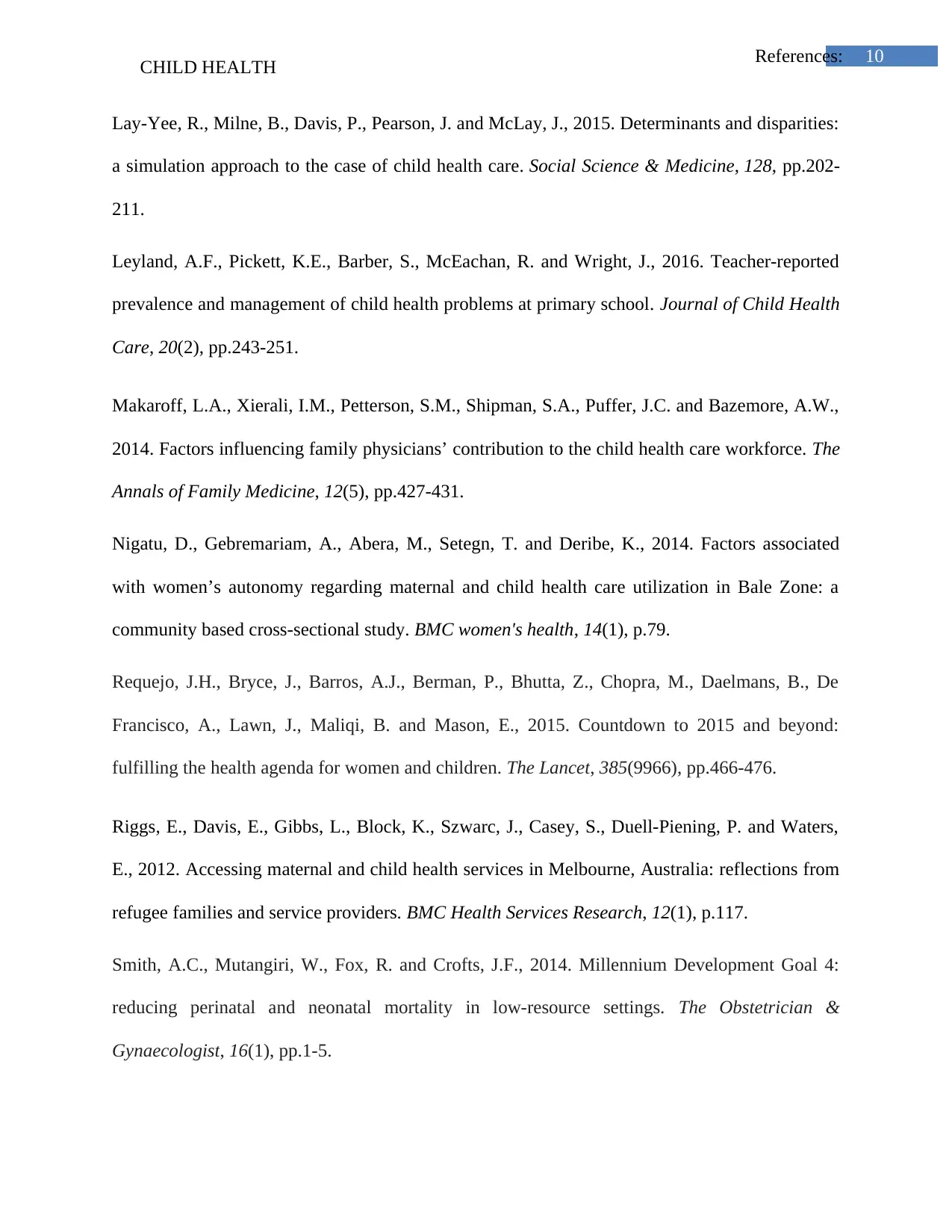
10References:
CHILD HEALTH
Lay-Yee, R., Milne, B., Davis, P., Pearson, J. and McLay, J., 2015. Determinants and disparities:
a simulation approach to the case of child health care. Social Science & Medicine, 128, pp.202-
211.
Leyland, A.F., Pickett, K.E., Barber, S., McEachan, R. and Wright, J., 2016. Teacher-reported
prevalence and management of child health problems at primary school. Journal of Child Health
Care, 20(2), pp.243-251.
Makaroff, L.A., Xierali, I.M., Petterson, S.M., Shipman, S.A., Puffer, J.C. and Bazemore, A.W.,
2014. Factors influencing family physicians’ contribution to the child health care workforce. The
Annals of Family Medicine, 12(5), pp.427-431.
Nigatu, D., Gebremariam, A., Abera, M., Setegn, T. and Deribe, K., 2014. Factors associated
with women’s autonomy regarding maternal and child health care utilization in Bale Zone: a
community based cross-sectional study. BMC women's health, 14(1), p.79.
Requejo, J.H., Bryce, J., Barros, A.J., Berman, P., Bhutta, Z., Chopra, M., Daelmans, B., De
Francisco, A., Lawn, J., Maliqi, B. and Mason, E., 2015. Countdown to 2015 and beyond:
fulfilling the health agenda for women and children. The Lancet, 385(9966), pp.466-476.
Riggs, E., Davis, E., Gibbs, L., Block, K., Szwarc, J., Casey, S., Duell-Piening, P. and Waters,
E., 2012. Accessing maternal and child health services in Melbourne, Australia: reflections from
refugee families and service providers. BMC Health Services Research, 12(1), p.117.
Smith, A.C., Mutangiri, W., Fox, R. and Crofts, J.F., 2014. Millennium Development Goal 4:
reducing perinatal and neonatal mortality in low‐resource settings. The Obstetrician &
Gynaecologist, 16(1), pp.1-5.
CHILD HEALTH
Lay-Yee, R., Milne, B., Davis, P., Pearson, J. and McLay, J., 2015. Determinants and disparities:
a simulation approach to the case of child health care. Social Science & Medicine, 128, pp.202-
211.
Leyland, A.F., Pickett, K.E., Barber, S., McEachan, R. and Wright, J., 2016. Teacher-reported
prevalence and management of child health problems at primary school. Journal of Child Health
Care, 20(2), pp.243-251.
Makaroff, L.A., Xierali, I.M., Petterson, S.M., Shipman, S.A., Puffer, J.C. and Bazemore, A.W.,
2014. Factors influencing family physicians’ contribution to the child health care workforce. The
Annals of Family Medicine, 12(5), pp.427-431.
Nigatu, D., Gebremariam, A., Abera, M., Setegn, T. and Deribe, K., 2014. Factors associated
with women’s autonomy regarding maternal and child health care utilization in Bale Zone: a
community based cross-sectional study. BMC women's health, 14(1), p.79.
Requejo, J.H., Bryce, J., Barros, A.J., Berman, P., Bhutta, Z., Chopra, M., Daelmans, B., De
Francisco, A., Lawn, J., Maliqi, B. and Mason, E., 2015. Countdown to 2015 and beyond:
fulfilling the health agenda for women and children. The Lancet, 385(9966), pp.466-476.
Riggs, E., Davis, E., Gibbs, L., Block, K., Szwarc, J., Casey, S., Duell-Piening, P. and Waters,
E., 2012. Accessing maternal and child health services in Melbourne, Australia: reflections from
refugee families and service providers. BMC Health Services Research, 12(1), p.117.
Smith, A.C., Mutangiri, W., Fox, R. and Crofts, J.F., 2014. Millennium Development Goal 4:
reducing perinatal and neonatal mortality in low‐resource settings. The Obstetrician &
Gynaecologist, 16(1), pp.1-5.
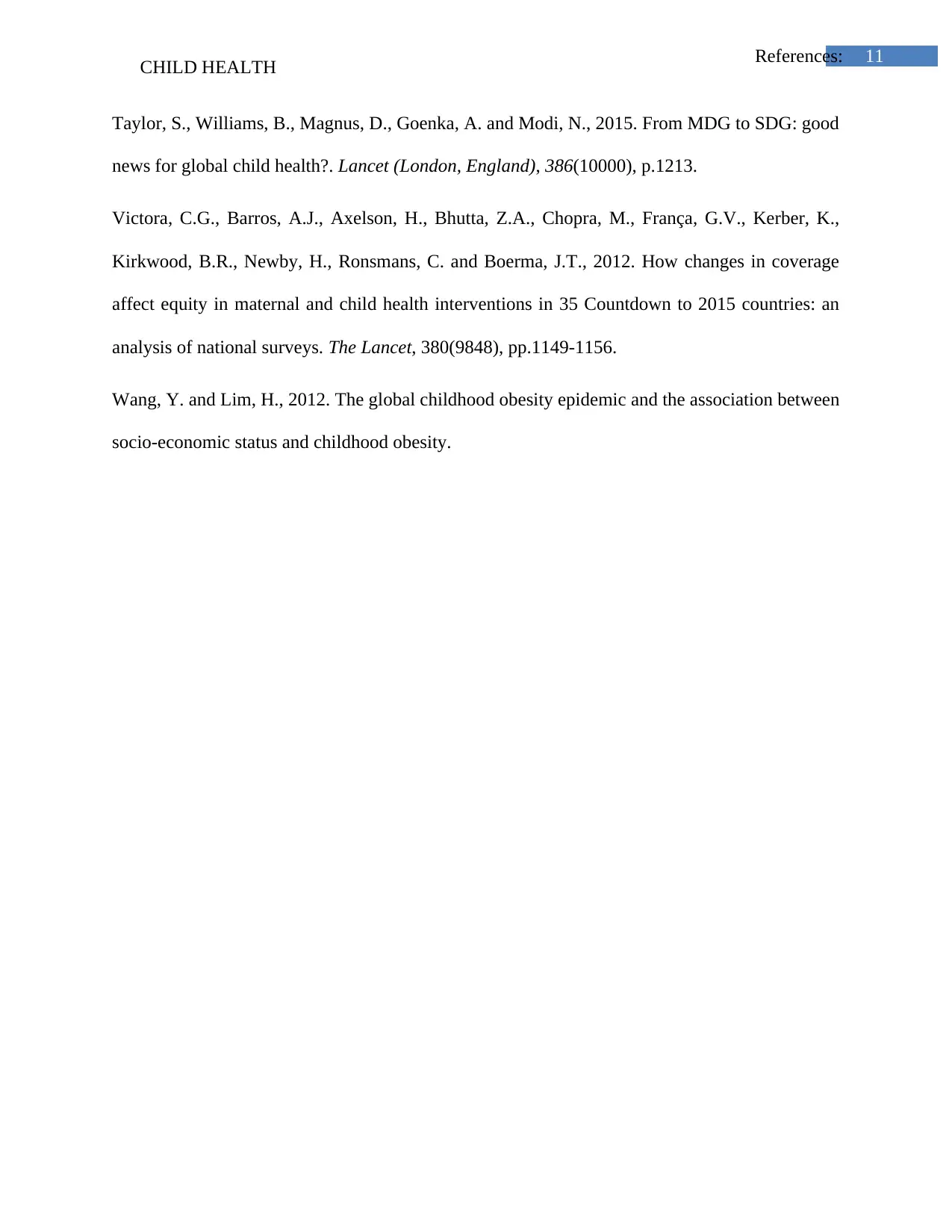
11References:
CHILD HEALTH
Taylor, S., Williams, B., Magnus, D., Goenka, A. and Modi, N., 2015. From MDG to SDG: good
news for global child health?. Lancet (London, England), 386(10000), p.1213.
Victora, C.G., Barros, A.J., Axelson, H., Bhutta, Z.A., Chopra, M., França, G.V., Kerber, K.,
Kirkwood, B.R., Newby, H., Ronsmans, C. and Boerma, J.T., 2012. How changes in coverage
affect equity in maternal and child health interventions in 35 Countdown to 2015 countries: an
analysis of national surveys. The Lancet, 380(9848), pp.1149-1156.
Wang, Y. and Lim, H., 2012. The global childhood obesity epidemic and the association between
socio-economic status and childhood obesity.
CHILD HEALTH
Taylor, S., Williams, B., Magnus, D., Goenka, A. and Modi, N., 2015. From MDG to SDG: good
news for global child health?. Lancet (London, England), 386(10000), p.1213.
Victora, C.G., Barros, A.J., Axelson, H., Bhutta, Z.A., Chopra, M., França, G.V., Kerber, K.,
Kirkwood, B.R., Newby, H., Ronsmans, C. and Boerma, J.T., 2012. How changes in coverage
affect equity in maternal and child health interventions in 35 Countdown to 2015 countries: an
analysis of national surveys. The Lancet, 380(9848), pp.1149-1156.
Wang, Y. and Lim, H., 2012. The global childhood obesity epidemic and the association between
socio-economic status and childhood obesity.
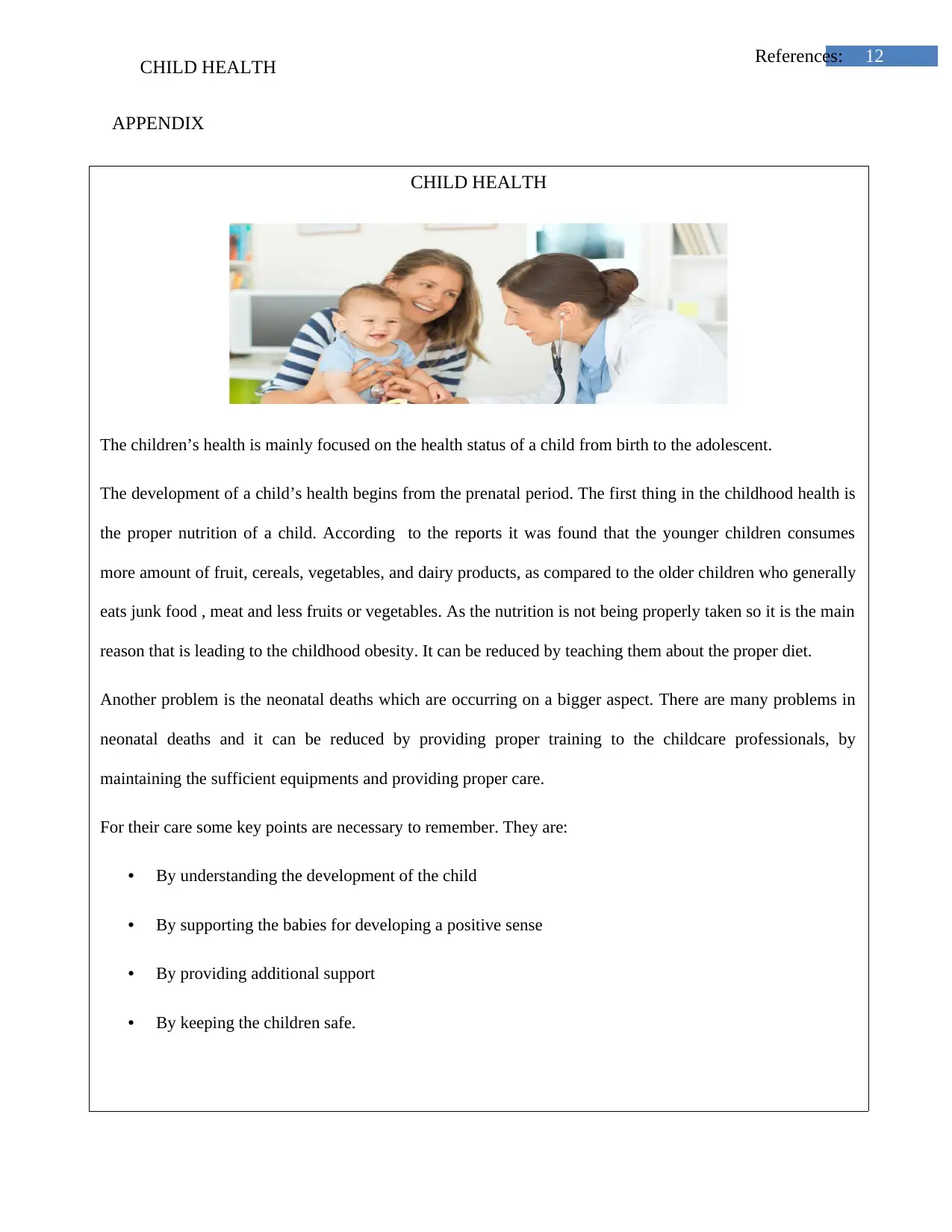
12References:
CHILD HEALTH
APPENDIX
CHILD HEALTH
The children’s health is mainly focused on the health status of a child from birth to the adolescent.
The development of a child’s health begins from the prenatal period. The first thing in the childhood health is
the proper nutrition of a child. According to the reports it was found that the younger children consumes
more amount of fruit, cereals, vegetables, and dairy products, as compared to the older children who generally
eats junk food , meat and less fruits or vegetables. As the nutrition is not being properly taken so it is the main
reason that is leading to the childhood obesity. It can be reduced by teaching them about the proper diet.
Another problem is the neonatal deaths which are occurring on a bigger aspect. There are many problems in
neonatal deaths and it can be reduced by providing proper training to the childcare professionals, by
maintaining the sufficient equipments and providing proper care.
For their care some key points are necessary to remember. They are:
• By understanding the development of the child
• By supporting the babies for developing a positive sense
• By providing additional support
• By keeping the children safe.
CHILD HEALTH
APPENDIX
CHILD HEALTH
The children’s health is mainly focused on the health status of a child from birth to the adolescent.
The development of a child’s health begins from the prenatal period. The first thing in the childhood health is
the proper nutrition of a child. According to the reports it was found that the younger children consumes
more amount of fruit, cereals, vegetables, and dairy products, as compared to the older children who generally
eats junk food , meat and less fruits or vegetables. As the nutrition is not being properly taken so it is the main
reason that is leading to the childhood obesity. It can be reduced by teaching them about the proper diet.
Another problem is the neonatal deaths which are occurring on a bigger aspect. There are many problems in
neonatal deaths and it can be reduced by providing proper training to the childcare professionals, by
maintaining the sufficient equipments and providing proper care.
For their care some key points are necessary to remember. They are:
• By understanding the development of the child
• By supporting the babies for developing a positive sense
• By providing additional support
• By keeping the children safe.
1 out of 13
Related Documents
Your All-in-One AI-Powered Toolkit for Academic Success.
+13062052269
info@desklib.com
Available 24*7 on WhatsApp / Email
![[object Object]](/_next/static/media/star-bottom.7253800d.svg)
Unlock your academic potential
© 2024 | Zucol Services PVT LTD | All rights reserved.





